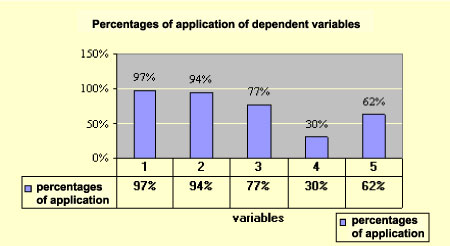
| Sociolingüística catalana |
| An approximation to the study of processes of linguistic change in non-prestigious geographical varieties: the Conca de Tremp, by Sílvia Romero Galera |
||||
| CONTINUA |
According to the results of the processing of our data, the full forms of singular weak pronouns are in an advanced process of substitution with a probability of application of the variable of loss of full singular pronominal forms of 0.967 (see Figures 1 and 2). We have suggested a number of reasons to explain why this marked feature presents a slightly lower probability of application of the variable when compared with the variable of the definite article: the most significant reason is the availability of the full forms in general use, specifically in binary enclitic and proclitic combinations before pronouns that are not hi, ho, and the current stylistic recommendation of using the full form of the third person before verbs that begin with [s–]. This second aspect could explain the percentage results, which indicate a slightly greater conservatism in the third person, compared with the first person, which has practically been replaced by the reinforced form. The probabilistic results ratify these signs, given that the first person favours application of the variable, whereas the third person does not. Following the line opened up by the analysis of other variables, we have observed the same behaviour of the explanatory factors of prepared speech and university education & knowledge of written Catalan in that they favour application of the variable, compared with spontaneous speech and secondary education or professional training & lack of knowledge of written Catalan, which do not favour the appearance of reinforced variants. As regards the preceding articulatory context group of factors, our hypotheses are confirmed, with the result that the presence of a preceding vowel favours application of the variable, whereas a pause or preceding consonant do not. These overall results, which indicate a clear prevalence of reinforced forms in current oral usage of the speech of Conca de Tremp, differ slightly from the information available on other zones in the western domain, characterised by a greater use of full forms, at least in alternation with reinforced forms. Figure 1. Percentages of application of dependent variables 
Finally, in the analysis of the behaviour of the variable of loss of the forms in u of the possessive feminine adjective, we find a situation of alternation that increasingly favours new variants, since the percentage of application of the variable is 62% (see Figure 1). By factors, and in line with the majority behaviour of the rest of the features, prepared speech and university education & knowledge of the written language revealed high percentages of pronunciations with –v–, whereas, the percentages of variants related to spontaneous speech and secondary education or professional training & lack of knowledge of written Catalan are very low. By age, we obtain a stratification in the use of variants with –v– ranging from lowest in informants aged over 55, to highest in the range of under-30’s, passing through an intermediate level in informants aged between 30 and 55, which attributes to the latter the classic characteristic of generation of transition. |